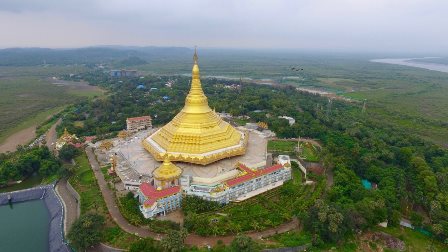 All are most welcome to visit the Global Vipassana Pagoda, and to start
experiencing the immeasurable benefits from accurate and ardent practice of Vipassana meditation - and to understand the true purpose of human life.
All are most welcome to visit the Global Vipassana Pagoda, and to start
experiencing the immeasurable benefits from accurate and ardent practice of Vipassana meditation - and to understand the true purpose of human life.Visiting the Global Pagoda is free of charge. There is no entry fee. No charges for the tour guide.
Timings: 9.00 am to 7.00 pm. The Global Vipassana Pagoda is open all days, including Sunday.
(The last ferry leaves Gorai jetty to the Global Pagoda at 5.25 pm)
* Vipassana students - those who have taken one or more 10-day Vipassana courses taught in the tradition of Sayagyi U Ba Khin - are permitted to meditate inside the main dome Dhamma Hall of the Global Pagoda.
* Simple food facilities are available in the Global Pagoda premises.
* Safe drinking water and clean toilet / wash-room facilities are available in the Global Pagoda premises.
* Non-commercial photography is permitted in the Global Pagoda. There can be no copyright to any image of the Global Vipassana Pagoda - visuals are to be made freely available to all for non-commercial use.
* For any clarification / questions, please contact Global Vipassana Foundation, Mumbai, India, Telephone: 91 - 22 - 33747501; Email: pr@globalpagoda.org
How to reach Global Vipassana Pagoda, Gorai / Borivali, Mumbai, India:
The Global Pagoda can be reached overland by car, as well by ferry. Pre-paid taxi services are available at the Mumbai domestic and international airports. Ask for "Esselworld", if "Global Vipassana Pagoda" draws a blank stare. The Global Pagoda is adjacent to Esselworld Park.
Reaching Global Vipassana Pagoda by Road from Mumbai City / Domestic Airport / International Airport / Railway Stations in Mumbai
- Reach Western Express Highway and go North towards Dahisar/Borivali/Ahmedabad.
- Cross the Dahisar Toll Booth and keep going straight.
- When you reach the Mira-Bhayandar crossing, turn Left towards Mira-Bhayandar. The crossing has a statue of Shivaji Maharaj positioned at the centre.
- Keep going straight till you reach Golden Nest Circle. At the Golden Nest Circle, take a left turn and stay on the main road.
- Keep going straight till you take a hard right turn at the end of the road. This point will come after Maxus Mall, which comes on your right. After the hard right turn, take a left at the T point junction.
- Keep following directions to Esselworld or Global Vipassana Pagoda from this point forward.
- When you reach the Esselworld Parking Lot, go ahead a few metres and take a right turn towards Esselworld. Tell the guard at the security post that you want to go to the Pagoda.
- Keep going straight till you reach the Helipad. At the Helipad, take a right turn to the Global Pagoda Road through the Sanchi Arch.
Hiring a car for airport pick-up to Global Vipassana Pagoda:
Private taxis and vehicles can also be hired from many car rentals in Mumbai, besides the airport pre-paid taxi service. Rates may vary. Many Vipassana students make use of the services of private taxi operator Mr Jagdish Maniyar. Contact : Tel (Res): 91-22-26391010 or cell phone 09869255079. As of February 2011, Mr Maniyar charges Rs 800 ( approx US $17, 13 Euros) for airport pickup to Global Pagoda (inclusive of road taxes). From Mumbai airport to Dhamma Giri Vipassana centre, Igatpuri, he charges Rs 2,550 (approx US $56).
From Borivali Railway station:
From Borivali Station (Western Railway, Mumbai) please use the western exit gates of the station (for the train from Churchgate, the exit is on the left). One can take Bus number 294 or hire an auto rickshaw (tuk-tuk) to Gorai Creek. The bus fare is Rs. 6 and auto rickshaw fare is approx Rs. 25 (approx US $0.50) to Rs 35.
For the auto-rickshaw, please take one heading to your right, after crossing the road from the western exit of the railway station. The Gorai jetty is approximately 10-15 minutes-ride from Borivili station. Please take the ferry for Esselworld from Gorai Jetty. The return fare for the ferry is Rs. 35/- per person.
On arrival at Esselworld, you will see signs guiding to take you to Global Pagoda (which anyway is too big to be missed !).
The Dhamma Pattana Vipassana Centre is less than five minutes walking distance from the Esselworld Jetty gate.
Other Bus Numbers to Gorai: From Kurla railway station (West) - 309 L; From Mulund station (West) - 460 L;From Ghatkopar Bus Depot - 488 L (please re-confirm before boarding bus)
Wishing you a very happy and most beneficial visit to the Global Pagoda.
For any further details and assistance, please contact:
Global Vipassana Pagoda
Telephone: 91 22 33747501 (30 lines)
Email: pr@globalpagoda.org
Pagoda Address:
Global Vipassana Pagoda
Next to Esselworld, Gorai Village,
Borivali (West), Mumbai 400091
For sending any post/courier, please use this address:
Head Office Global Vipassana Foundation
2nd Floor, Green House, Green Street, Fort
Mumbai – 400 023
Telephone: +91 22 22665926 / 22664039
Fax: +91 22 22664607
Dhamma Pattana Vipassana Centre
Inside Global Vipassana Pagoda Campus
Next to Esselworld, Gorai Village,
Borivali (West), Mumbai 400091
Tel: [91] (22) 3374 7519
Fax: [91] (22) 3374 7518
Email: info@pattana.dhamma.org
* Vipassana meditation courses worldwide, course venues, online application for beginners' 10-day residential Vipassana courses
* Dhamma reasons why there are no fees are charged for Vipassana courses - including for boarding and lodging
* One-day Vipassana courses at Global Pagoda (for those who have completed a 10-day Vipassana course)


